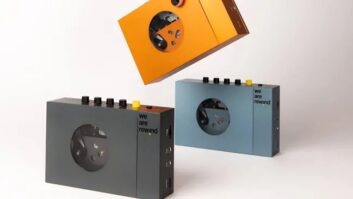Rancho Bernardo, Calif. — Armed with a newly realigned and centralized sales and marketing team, and a world-class brand image, consumer electronics retailers can look for Sony to be more “boldly aggressive” and faster to react to market demands than in the past.
That was the assessment of Stan Glasgow, Sony’s consumer sales president, who moved into his post April 1 after a successful stint overseeing sales of Sony’s IT products group.
Under his watch, Glasgow said Sony will continue its heavy focus on television display products, digital imaging (including still cameras and digital camcorders), personal audio and VAIO computer products.
At the same time, the company will maintain its leadership in the higher-end segment of the categories in which it participates, while bracing for the change expected from the entry of Asian manufacturers and traditional IT vendors into key consumer electronics categories, including flat-panel TV.
Meanwhile, the company is stepping away from the temporarily low-profile posture that had preceded its recent sales and marketing realignment in the San Diego area to bring new executives out into the forefront, while engaging in one of the most aggressive brand advertising and promotional campaigns in years, Glasgow said.
Retailers can expect the same high level of service and support they have come to expect from Sony, despite the loss of some popular upper-level executives, who elected to leave Sony rather than relocate to the West Coast, he added.
“What really happened is that some of the very senior executives, who spent 20-plus years in sales, left the company,” he explained. “Those relationships were important, I’m sure, with some retailers, and their loss was certainly felt. But the basic senior sales team has been here an average of 15 to 20 years.”
Glasgow said one of the primary reasons for the move was to expedite product planning, marketing and sales procedures to better react to market demands.
“The purpose of the consolidation was to give Sony the ability to move quicker in the marketplace by bringing sales teams together with marketing teams, where we could make decisions together on what products we should introduce, when we should introduce them, and make those moves more quickly than we had in the past,” said Glasgow.
He also vowed be more aggressive in sales and distribution at the mass market level, while ensuring Sony maintains its dominant role with A/V specialty dealers, and custom installers.
“Now and in the future, we are going to address not only the upper end of the market but the core lower-priced categories,” he said. “We are going to get more aggressive across the entire range of products, rather than be selectively focused.”
Hinting at distribution changes to come, Glasgow said he is cognizant of the growing presence of Wal-Mart in the consumer electronics space, and added “I see warehouse clubs being more prominent,” while “small A/V specialists that really cater to people continue to play a vital role in building the industry.
“Consumers are shopping in a wider variety of stores than in the past,” Glasgow observed. “We are going to continue a further expansion by supporting each channel more heavily. We probably didn’t support some of the lower-margined channels as much as we could have in the past.”
As for Sony’s successful high-end XBR television sub-brand and the recently launched ultra-elite Qualia series, Sony can be expected to “expand those offerings to ensure we have a true margin-generating upper series of products,” he said. “We might add another [sub-] brand on top of that, depending on what we do going forward.”
For the lower-end, Glasgow said Sony may elect to offer differentiated products for key accounts.
He showed little concern with the prospect of increased competition from new price-oriented Asian competitors.
“I lived a little over 20 years in Asia and managed Asian manufacturing companies, so I have a pretty good understanding of that part of the world,” said Glasgow. “I think we need that type of competition. It is going to bring better prices for better products to the consumer, and I am all in favor of that.
“The edge Sony has is its 50 years of skill set in understanding what types of televisions people like,” he continued. “We have certain skills in product design, marketing and in sales. I feel very comfortable that we are in a good position to compete.”
Although some demographic studies show a growing market segment in young, value-oriented, tech-savvy consumers who are less brand-conscious than in the past, “Sony recognizes that there are multiple segments of consumers out there. We know there are a lot of young, very hip, very tech-savvy kids. We are going after them with a series of products…If you look at our entire IT line, our notebooks are skewed toward very high-end professionals or kids that really understand and want to be cool with computer products. Similarly, I think you will see our range of audio products being extremely sleek and adept for those kids who understand how to take advantage of them.”
Glasgow blanched at the notion that some perceive Sony to be losing its development edge in video display technologies because it hasn’t had its own plasma and LCD panel production facilities, while continuing to push CRT technologies, which some view as antiquated.
“There are all types of displays for different people, but in my personal opinion there is still no better display for HDTV than CRT. It’s not the thinnest or the lightest technology, but it delivers the best picture performance. We are going to continue with that product until the performance of LCD, plasma, OLED, light emitting, holographic or whatever the next technology is going forward is able to eclipse that.”
Glasgow acknowledged that there is less performance differentiation between plasma and LCD products than there is between different CRT systems, “but if you look at what Sony has done in LCD and plasma — we have added the WEGA engine that optimizes the color balance, uniformity and reproduction to be as close to a Trinitron as we can get it.”
As for personal audio, a concept literally founded by Sony through it’s Walkman ventures, the company is responding to challenges from Apple’s successful iPod hard-disc portable players, he said.
“Sony has the widest range of products in that category than any company around,” he said. “We don’t just have disc players. We have a full range of 28 different products that are capable of downloading music, among other capabilities. I understand that Apple beat us to the punch with hard-disc players. But we offer a complete range of products from $99 to $399 that let you download songs on different media, not just hard-disc players for $299 and $399.”
Glasgow said his biggest challenge will come in the IT business, where Dell and HP are “monstrous” competitors. He pointed out the VAIO computer line has been re-branded and re-emphasized for the future, he added.
“We still have a very commanding presence [in IT], and every month I see us growing our skill set to be more relevant in the computer marketplace.”













